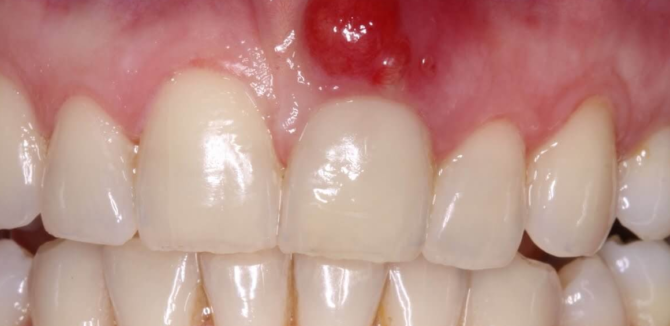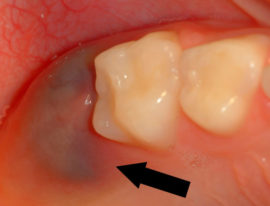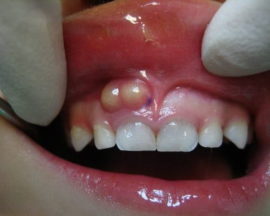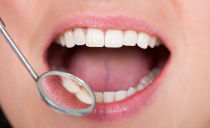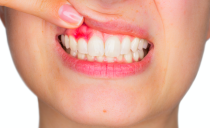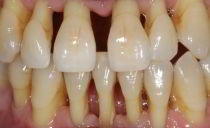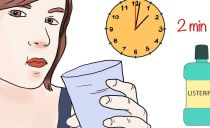A cyst on the gum near a tooth in an adult and a child: causes, symptoms, removal, treatment and alternative therapy
A cyst on the gum near the tooth is a cavity filled with a substance, often purulent. Cystic formation occurs as a result of the body's reaction to an infectious attack in the gingival bone. With timely access to a doctor, cystic formation is treated successfully, without relapse and consequences.
Content
Locations and causes of cysts
Cystic neoplasms vary in location. In most cases, they affect incisors and fangs, less often develop in the area of molars, close to the maxillary sinuses.
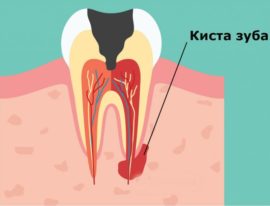 The main reason for the appearance of education is caries. A tooth lesion can reach its root, root inflammation (periodontitis) is accompanied by an accumulation of purulent masses and can lead to the formation of a radicular cystic mass. As the pus at the root becomes more and more, it rushes to the surface of the gums. As a result, a purulent capsule forms on the gum, which develops into a granuloma.
The main reason for the appearance of education is caries. A tooth lesion can reach its root, root inflammation (periodontitis) is accompanied by an accumulation of purulent masses and can lead to the formation of a radicular cystic mass. As the pus at the root becomes more and more, it rushes to the surface of the gums. As a result, a purulent capsule forms on the gum, which develops into a granuloma.
The follicular cyst occurs as a result of infection of the embryo from which the tooth is formed. The neoplasm is located on top of the embryo, blocking its normal development. With the formation of a follicular cyst on the gum, an operation is necessary. In this case, surgery is the only way out.
A cyst can occur as a result of natural processes of formation and appearance of milk teeth during their teething in infants.
The primary formation or keratocyst can be localized in different parts of the interdental space, which leads to a displacement of the dentition. Behind the teeth of wisdom in the lower jaw, a retromolar formation is localized. The occurrence of these cysts is due to inflammation of the teeth. Education covers the molar from above.
The main causes of the appearance of a cyst include:
- damage to dental tissue with caries;
- periodontitis, periodontitis;
- mechanical injuries;
- infection (gingival and bone tissues are affected);
- congenital malformations;
- inflammatory processes in the nasopharynx;
- infection of the root canal during treatment;
- improper installation of prostheses, prosthetics of diseased teeth.
Regardless of the root cause of the appearance of the neoplasm, a specialist should diagnose a cyst on the gum and determine the direction of treatment (in the clinic, at home).
Symptoms of a cyst in the gum of a tooth
Cystic neoplasm is dangerous because in the early stages it develops asymptomatically. With prolonged development of the cyst in the gum near the patient’s tooth, symptoms such as pain when pressing on the tooth, slight swelling may disturb. With a decrease in immunity, for example, during a cold, the infection worsens, which can lead to fever, acute pain.
Recognize a cyst in the gum near the tooth by the following symptoms:
- Discoloration of the gums. It darkens or acquires an unnatural shade: yellowish, greenish, bluish, grayish.
- The tooth loses its stability and begins to shift.
- A small lump on the gum develops into a full-fledged formation 2-3 cm in size.
- There is discomfort during eating. Unpleasant sensations are caused by soft food, solid food provokes soreness.
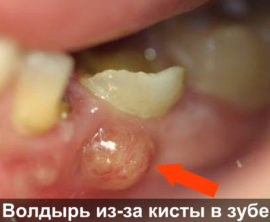 Subsequently, pain occurs, a fever is possible.
Subsequently, pain occurs, a fever is possible.- Lymph nodes increase, touching them can cause unpleasant pain.
- With further progression of the inflammatory process, an increase in the volume of the cystic substance occurs, and it tends to leave the periglossal space, moving towards the gums. As a result, the gum swells, and a purulent flux appears on it - how it looks is shown in the photo.
Possible complications and consequences of a cyst in the gum of a tooth
The development of cysts in the gums near the tooth is fraught with serious consequences and complications:
- The occurrence of purulent abscesses: an acute inflammatory process in the root, purulent inflammation of the periodontium.
- Loss of teeth that lose stability fall out of the cystic cavity.
- The formation of phlegmon (purulent formations) in the neck, face.
- The occurrence of an acute inflammatory process in the periosteum (periostitis).
- Osteomyelitis is an acute inflammation of the bone tissues of the jaws, leading to their complete destruction.
- The appearance in the gingival tissue of benign neoplasms.
- In especially severe, advanced cases, sepsis (blood poisoning) is possible.
A cyst on the gum near a child’s tooth
In case of detection of a tooth cyst in a child, you should immediately take him to a specialist. The main causes of cystic formations in children are injuries, infections of the oral cavity, improper treatment of dental diseases. Often, a cyst occurs in the process of teething - the formation can affect both the milk tooth and the rudiment of the forming constant.
Ignoring the cystic formation in a child is fraught with defeat of not only milk, but also forming permanent dental units. It is necessary to start treatment of the disease as soon as possible, untimely started therapy can cause the development of serious dental problems.
The focus of infection, concentrated in the tooth cyst, can spread throughout the children's body. As a result, existing chronic diseases may worsen, it is possible the addition of new pathologies. Infection can affect the organs of the gastrointestinal tract, urinary system, ENT organs. Immunity decreases, the child begins to get sick more often.
Only a specialist can determine how and with what to treat a cyst on the gum in a child, since the treatment of cystic formations in children has a lot of nuances. The treatment method directly depends on which tooth is affected by the neoplasm. So, if the formation appeared near the milk tooth, it is removed. Cystic formations on the permanent teeth of a child can be cured using standard methods used for adults.
It must be borne in mind that early loss of primary teeth can provoke deformation, curvature, and disturbance in the placement of permanent dental units. In addition to aesthetic problems, such defects can lead to facial asymmetry, early ptosis (drooping) of the facial muscles, malocclusion. Therefore, after removal of the milk tooth, an orthodontist must be consulted to prevent possible consequences.
It is possible to treat a neoplasm on the gum in a child with folk remedies only on the recommendation of a doctor. Before visiting a specialist, you can alleviate the condition of the child at home with a decoction of chamomile mouthwash.
Treatment of cysts on the gums: at home and removal
Treatment of cysts on the gums near the tooth includes surgery and subsequent medication with concomitant treatment with folk remedies.
Surgical removal
The surgical stage of therapy includes several gentle tooth-preserving procedures, such as cystotomy, cystectomy, hemisection. A radical method of treatment, involving the removal of a cystic formation and an affected tooth, is used in especially severe and neglected cases.
The essence of gentle methods of surgical intervention:
- Carrying out a cystotomy involves opening, cleansing the cystic cavity and subsequent administration of an antiseptic into it. This intervention is characterized by easy tolerance, but a long healing period, during which it is necessary to regularly perform treatment and prophylactic procedures for the oral cavity.
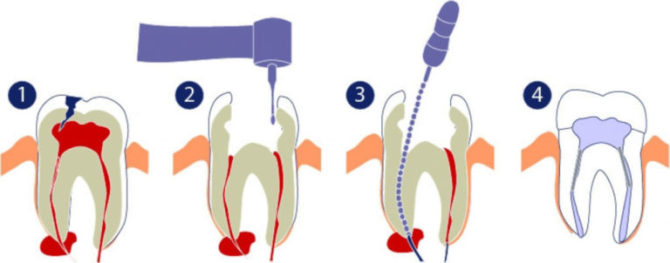
- A more extensive operation, including complete removal of the cyst on the gum and the affected part of the root of the tooth, is called cystectomy. After removal of the affected elements, the cavity is cleaned, filled with a regenerating substance and sutured.

- Hemisection is performed with a root lesion, which can lead to pathological processes that destroy the jaw bone. This operation involves the removal of a cystic formation, the affected root and part of the tooth. The resulting cavities are filled with bone-plastic material and sutured.
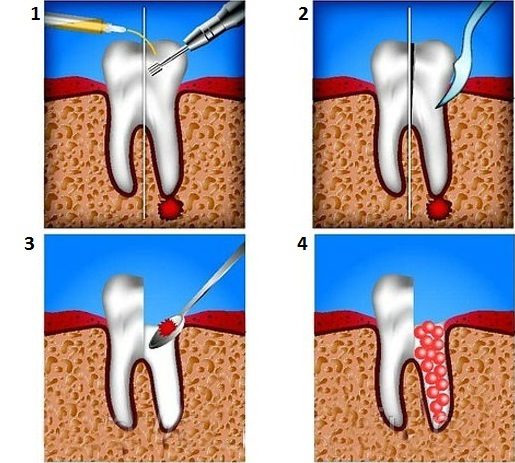
After removal of the cyst, dentists prescribe antibiotics (Amoxiclav, Sumamed). Antibiotic therapy allows you to quickly deal with the infection, prevents possible complications and consequences.
Folk remedies at home
After the operation to remove the cyst from the gums, the doctor can prescribe treatment with folk remedies. Effective recipes used at home are:
- Lemon juice. One dessert spoon of lemon juice is dissolved in a glass of warm boiled water. Rinsing the mouth should be done twice a day.
- A compress with sesame oil helps to quickly remove the swelling. A piece of cotton wool is wetted in oil and applied to the lump on the gum. Compress should be done twice a day.
- Fresh burdock juice. The plant is rinsed, ground, strained. Fresh juice is infused in a dark place for several days. It must be ensured that he does not ferment. The tool is taken orally twice a day for 2 tablespoons.
In addition to discomfort and pain, cystic formation on the gum is fraught with serious consequences. If signs are found that indicate its development, it is necessary to immediately visit dentistry and consult a specialist.

